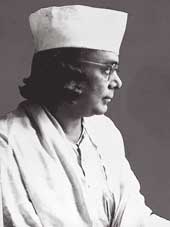"Tribhubôner Priyô Muhammad"[1][2] (Bengali: ত্রিভুবনের প্রিয় মুহাম্মদ, lit. 'Muhammad, the beloved of tri-dimension') is a nasheed or ghazal composed by the Kazi Nazrul Islam, celebrating the birth of Muhammad. The ghazal was composed in 1935, in the melody of "Kâtibim", a traditional Turkish folk music.[3][4] Nazrul's first song in the melody of Kâtibim was "Shukno Patar Nupur Paye", which was recorded by Harimati Devi in 1933. Tribhuboner Priyo Muhammad came out two years later in 1935 in the same melody, featuring the voice of Nazrul's disciple and connoisseur Abbasuddin Ahmed.[4]
| "Tribhubôner Priyô Muhammad" | |
|---|---|
 | |
| Song by Abbasuddin Ahmed | |
| Written | Kazi Nazrul Islam |
| Published | 1935 |
| Released | 1935 |
| Recorded | 1935 |
| Genre | Nazrul Geeti, Ghazal |
| Songwriter(s) | Kazi Nazrul Islam |
| Composer(s) | Kazi Nazrul Islam |
| Lyricist(s) | Kazi Nazrul Islam |
| Music video | |
| "Tribhubôner Priyô Muhammad" by Kalarab on YouTube | |
Background of the melody
editThe melody of Tribhubôner Priyô Muhammad was considered to be inspired from Arabic folk music once. According to the researcher Asadul Haque in his article titled "Successful application of Arabic melody in Bengali songs by composer Nazrul" (সঙ্গীতজ্ঞ নজরুলের বাংলা গানে আরবি সুরের সুষ্ঠু প্রয়োগ) in published the Dainik Ittefaq, he heard the same melody of a Turkish song while staying at Ankara, Turkey In 1965.[4] He became doubted about the claimed Arabic origin of that melody and went out for research.[4] When he went to Syria in an official trip, he asked a local old person who replied that it was "a thousand-year-old melody" of the Syrian song "Ya Banat Iskandaria" (Arabic: يا بنات اسكندريّة) meaning "Oh Girls of Alexandria",[5] the Turkish version of which is known as 'Kâtibim'. The song is about a girl and her clerk while visiting Üsküdar.[4]
No clear reference exists about where Nazrul got the melody of this nasheed or from whom he learned it. Some researchers believe that Nazrul got the melody of Kâtibim from the soldiers of the Bengal Regiment, who were sent to Iraq for training against the German forces in 1914 at the beginning of the World War I.[6]
Lyrics
edit| Bengali | English |
|---|---|
ত্রিভুবনের প্রিয় মুহাম্মদ এলো রে দুনিয়ায়। |
Muhammad, the beloved of three dimensions, has come to the world |
References
edit- ^ banglaislamigaan (2011-02-27), Tri-vuboner prio Muhammad. naat-e-rasul nat islami gajal nazrul songit bangla islami gaan, retrieved 2016-09-22
- ^ Priyo Muhammad, Tri Vuboner (August 24, 2022). "Tri Vuboner Priyo Muhammad". Sur Onuragi. SurOnuragi. Retrieved August 24, 2022.
Tri-vuboner priyo Muhammad
- ^ Deshkal, Shampratik. "নজরুলের ইসলামী সংগীত সৃষ্টির নেপথ্য ইতিহাস" [Background of Nazrul's creation of Islamic music]. Shampratik Deshkal (in Bengali). Retrieved 2022-07-12.
- ^ a b c d e "নজরুলের গান, ত্রিভুবনের সুর" [Nazrul's song, the melody of three dimensions]. www.anandabazar.com. Retrieved 2022-07-27.
- ^ Tesha Teshanovic (2010-05-17), Mohammed El-Bakkar - Banat Iskandaria, retrieved 2018-03-09
- ^ "কবি নজরুলের সৈনিক জীবন" [Soldier life of Poet Nazrul]. Chandpur Times (in Bengali). Retrieved 2022-07-12.